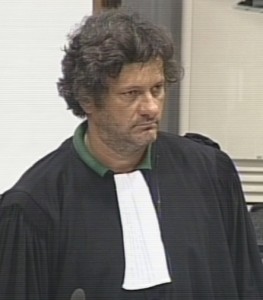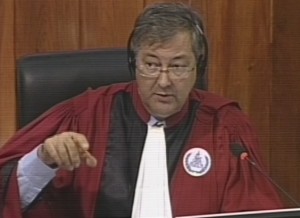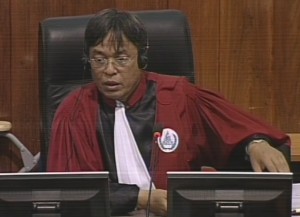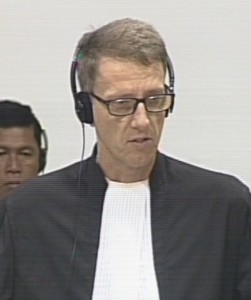“This is a farce” – Defense Teams Boycott Proceedings
Hearings at the ECCC took an unexpected turn today when both national and international defense teams for Nuon Chea and Khieu Samphan boycotted the proceedings and left the courtroom. Leading to this was an ongoing discussion on the use of written records of witness interviews in the course of key document hearings. Both defense teams opposed this practice with regards to records of interviews of witnesses who were still alive, while the Prosecution argued in favor of using these documents. When the Chamber decided that all written records of interviews could be used, including those of witnesses who had not passed away, Mr. Victor Koppe decided to leave the room. Shortly after, he was followed by his international counterpart, Khieu Samphan Defense Counsel Arthur Vercken.
Initially, key document hearings were scheduled for today relating to the sites of the 1st of January Dam, Kampong Chhnang Airport, and Trapeang Thma Dam Construction Site. Senior Assistant Prosecutor Vincent de Wilde had presented a few documents, before the disagreements brought the proceedings to a halt.
First objections
At the start of the hearing, the Trial Chamber Greffier confirmed the presence of all parties except Nuon Chea who was participating from the holding cell. Today’s document hearings would resort around the 1st of January Dam, Kampong Chhnang Airport and Trapeang Thma Dam Construction site. The next document hearings will deal with documents on context and policies, so these should be avoided in the present key document hearing.

International Khieu Samphan Defense Counsel Arthur Vercken
Before the Prosecution took the floor, Khieu Samphan Defense Counsel Arthur Vercken referred to an e-mail the defense team had sent to the Trial Chamber yesterday evening. He claimed that the list of documents that the Co-Prosecution intended to use was “against the rule” that key document hearings should not constitute a debate on the admissibility of documents. Mr. Vercken saw three problems with the list the Prosecution submitted. First, Mr. Vercken pointed to document D195.7, which had never been listed by any party and never been admitted into evidence. Second, only one page of document E342/1 had been admitted into evidence.[1] If the Prosecution wanted to use other pages they should file a rule 87(4) motion, he argued. Third, eighteen written records of interviews had been put on the list by the Prosecution that came from ongoing investigations – case 003 and case 004 that is. 1355 documents are still under the process in cases 003 and 004. Thus, these documents had been “forwarded illegally”. The only documents that could be excepted, according to Mr. Vercken, would be testimonies from witness before they appear or exculpatory documents. “We therefore object to this practice that consists in allowing the Prosecution to do what they wish to do in complete contradiction with the rules that you have set.” According to Mr. Vercken, the trial chamber had decided that the documents that were filed during the trial by the Prosecutors and that have just been received “are only documents that are inculpatory.” Mr. Vercken therefore requests the chamber to forbid the use of the mentioned documents.
Deputy Co-Prosecutor William Smith replied that the Prosecution will not be using document E342.1. With regards to E195.7, that had not been admitted in court but was on the case file, Mr. Smith clarified that this was a map. However, the Prosecution would refrain from using it. The other 18 documents had been admitted. By objecting to these documents, the “defense is saying that the Prosecution can’t put forward any documents that are inculpatory”. However, “that’s the Prosecution’s job.” Senior Assistant Prosecutor Travis Farr provided details about these 18 documents: On the May 25th, the Prosecution had filed an 87(3) and 87(4) motion, to which no party responded. On July 17th, the trial chamber declared all documents of this motion as admissible,[2] noting that “no Party had responded to the Prosecution motion.” At this point, Judge Fenz asked to clarify whether E319/21.3.19 was also on the list of admitted documents under this decision. When Mr. Farr answered that he would verify this before using this document.
In response to Mr. Smith’s explanation, Mr. Vercken stated that the Prosecution “appears not to understand what I have said.” Mr. Vercken stated that there “was no problem” with presenting inculpatory evidence. However, there are procedural rules that need to be respected. The scope of the trial had been set at the beginning to give the defense sufficient time to prepare. The Prosecution should not be allowed to continuously bring new inculpatory evidence into this trial.
“If we do so all the time means that there is no trial.”
President Nil Nonn replied that the defense made a submission already and the OCP had responded to it already.
Mr. Vercken stated the defense had filed a motion and that the submissions violate the rules. “The Prosecutor is preparing to violate the rules set by the trial chamber.”
Judge Jean-Marc Lavergne took the floor. He clarified that the Khieu Samphan Defense objected to three types of documents:

Judge Jean-Marc Lavergne
- One document that had not been admitted by the chamber;
- One document where only one page had been admitted, and
- E319 documents.
As for the E319 documents, Judge Lavergne stated that all these documents had been subject to a memorandum of the chamber of 17 July; according to the judge, it seemed like the defense was challenging the decision taken by the chamber. If that was the case, the defense should file a written request.
Presentation of Documents
At 9.40 am, the actual key document hearings started. Senior Assistant Prosecutor Vincent de Wilde took the floor to present documents regarding the 1st of January Dam. His structure would be as follows: first, he would present documents that gave general information on hydraulic and irrigation projects in Democratic Kampuchea. Second, he would present testimonies relating to the working conditions at the dam. Third, he would indicate documents related to purges. Fourth, he would introduce documents related to the visits of foreigners at the dam.
Mr. de Wilde then turned to his first topic.
a) General information on hydraulic and irrigation projects in Democratic Kampuchea
In this section, Mr. de Wilde presented seven documents.
First, he presented a four minute video entitled “Building a Khmer Rouge dam”[3] This video showed the construction of a dam (which was not the 1st January Dam) and the participation of youths, according to Mr. de Wilde. This black-and-white silent video presented women and men carrying baskets and men digging earth with hoes. One could see close-ups of people as well as footage that was taken from afar. In some parts of the video, the people were walking, in others they were running to transport soil.
Second, Mr. de Wilde showed a six second footage entitled “Khmer Rouge History of Genocide (Part 1)”[4] Here, one could hear someone saying that it showed Nuon Chea, Secretary of the party of Democratic Kampuchea, at the dam.
Third, the Senior Assistant Prosecutor presented the document “Kampuchea: a Revolutionary Economy”[5] of 1979. This document gave a general overview over the role of major irrigation systems during the Khmer rouge regime. Mr. de Wilde went on to cite parts of the document, which quoted a sentence of a lecture given by Ieng Sary: “The whole of Cambodia had been a huge construction site.” In the document it was further stated that refugees often reported that the dams were built without feasible studies and “in a chaotic measure”. Moreover, Mr. de Wilde quoted a Kkmer Rouge slogan: “all the people are mobilized to launch the offenses to build the country.” According to Mr. Wilde’s presentation of this document, the words used in relation to the construction of dams showed a military language, such as “fight”, “attack”, “offenses”, “battlefields” and food crops being described as “strategic crops”.
Fourth, Mr. de Wilde introduced the book “When the War was Over: Cambodia and the Khmer Rouge Revolution” by Elizabeth Becker.[6] Here, Ms. Becker, who visited the 1st of January Dam, described how the cadres of the Southwest Zone had been charged with the construction of the dam, and “people had to work around the clock.” The cadres who were responsible “had no experience with engineering”. According to her, the Dam was built in 1977 to irrigate 20,000 hectares of land with practically no mechanical equipment. According to this source, the dam burst during the rainy season in 1978, requiring repairs at numerous canals that “would not have been necessary if they had been built correctly in the first place.” Thus, political alignment was seen more important than technical skills.
Fifth, Mr. de Wilde pointed out the Site Identification Report from the Co-Investigating Judges for the 1st and 6th January Dam of February 23, 2009.[7] Here, Mr. de Wilde quoted that “although the entire irrigation system had been modernized, […] the original system still exists. The modern system is different in that the basin is a new construction and that the main channels are shorter. The basin was built in the 1990s in order to avoid the flooding.”
Sixth, Mr. de Wilde presented a report from 22nd December 1977, entitled “Account of the Visit to Cambodia of Chhim Yong Kuy,[8] indicating Ros Nhim’s role at the dam There, he cited that “comrade Nhim, second vice president of the Northwest Zone of the CPK declares that the reservoir had been built.” At the same pages of the report, it was stated that “Vice President Chhing Young Huy […] also visited January 1 Dam.” Moreover, the official Chinese report indicated that 10,000 hectares of land were irrigated with the Dam.
Lastly, Mr. de Wilde pointed to another report of 8 December 1977,[9] where it was indicated that Pol Pot, Ke Pauk, Aom An and others visited the dam with thousands of people welcoming them on site. Before turning to the next topic, Mr. de Wilde suggested taking a break. The president adjourned the hearing.
Objections to the Use of Written Records of Interviews
After the break, Mr. Koppe made two objections:
First, with regard to the first video which included four minutes of footage, the defense asked to know the section of footage that allegedly showed youths working at the dam, in order to be able to defend themselves against these allegations
Second, with regards to documents that are about to be shown, he had already made a similar objection during the previous document hearing with regard to Civil Party applications – he would not repeat the same objection. However, if the Prosecution intended to use written records of witness interviews, he would object. He reasoned that document hearings are designed to present books, articles, and contemporaneous documents and not to present witness statements.
Mr. de Wilde replied that, as for the first objection, the defense would have sufficient time on Monday to put these kinds of requests and would consider this as an interruption of the hearing. For the second objection, the Prosecution had often used contemporaneous documents. Nevertheless, there are fewer documents available as regards the 1st of January dam. Thus, he would present extracts of witness interviews of witnesses who are no longer alive. These would be three extracts of written records of interviews, and two which are very short. The rationale behind presenting these documents, according to Mr. Wilde, was to link some extracts of interviews with other evidence.

President Nil Nonn
After conferring for a few minutes, the chamber decided on the objections of Mr. Koppe. For the first one, the president stated that it would be helpful to clarify which seconds the Prosecution was referring to regarding child labor. For the second objection, the president announced that it was overruled in relation to key document hearings, “particularly concerning the written records of interviews of witnesses who have passed away already.” The chamber allowed parties to present such written records of interviews, “as long as parties can proof that the witness in the interview passed away.” As indicated in Trial Chamber document E315/1, documents should be limited to the relevant facts. Further, the president decided that the Prosecution would be given fifty more minutes to present their documents due to the late start of the presentation.
At this point, Mr. Smith took the floor, stating that the Prosecution did not intend to only use Written Records of Interviews of those people who already deceased. Instead, the Prosecution had looked at direct evidence and would present contemporaneous documents where these were to be found. However, books and articles are relying, according to Mr. Smith, on witness statements and the like and are therefore secondary sources. The Prosecution should thus be able to present Written Records of Interviews also of people who are still alive. The president restated that the objection by Mr. Koppe had been overruled in this part.
Mr. de Wilde took the floor to present further documents.
b) Working and living conditions
In today’s session, Mr. de Wilde presented three documents relating to working and living conditions, and will likely continue tomorrow.
First, Mr. de Wilde presented written record of interview of Ieng Chham alias Chhy[10], who was trained for six months in Phnom Penh to be a technician at the 1st of January Dam. According to the excerpts read out by Mr. de Wilde, Chham stated that he was sent to inspect work at the dam and described the procedures of constructing the dam. The Dam was completed in 1978. Moreover, the witness had stated that he had received “the master plan” from Ke Pauk, which was a simple picture. The dam was controlled by the North Zone. At the worksite, according to this witness’s interview, there was not enough medicine for the sick and medical staff seemed to not have been trained.
At this point, Mr. Koppe intervened, stating that the Prosecutor had not proven that this person had passed away. Judge Claudia Fenz clarified that the decision earlier during the hearing related to all witness statements and not only to witness statements of people who were already deceased. “This might have been a translation issue”, when the president made his first announcement. Thus, the ruling that written records of interviews can be used extends to all of them.

Nuon Chea Defense Counsel Victor Koppe
This prompted Mr. Koppe to state that “but then we will officially withdraw from our document presentation, because this is a farce.”
Mr. de Wilde continued presenting his document by stating that, according to the witness statement, after the disappearance of Sao, Ke Pauk had appointed the witness to take charge of the construction work. Sao was arrested, tortured and killed, as could be seen in S-21 Confession or Yap Yan alias Sao of September 25, 1977.[11]
At this point, Khieu Samphan defense counsel Arthur Vercken stood up, stating that the “Khieu Samphan defense considers also that this document hearing does not have its place in this trial and does not see why it should continue partaking in something that resembles more final statements than anything else. So, therefore, we would like to withdraw from the process.”
Juge Fenz put on record that the International Defense counsels for both teams were leaving the room. The national defense counsels seem to be staying, which “means that in this case we can go ahead.” At this point, Kong Sam Onn sought leave to withdraw from this proceeding,
“since I am working as a team in the defense team.”
Mr. Smith stood up, stating that the Prosecution had not been presenting arguments, but had been presented evidence in accordance with the rules.
“The behaviour of the defense is completely illogical.”
He then suggested to consider whether the standby counsel for Khieu Samphan should replace the counsel.
Mr. de Wilde started taking up the presentation of the Prosecution’s documents, but was interrupted. The National Lead Co-Lawyer for the Civil Parties Pich Ang had stood up on his feet, but decided differently and stated that he would “remain silent on this issue.”
After minutes passed in which the trial chamber conferred, Mr. Pich Ang took the floor again. The President reminded the Civil Parties Lead Co-Lawyer that he had stated earlier that he would remain silent. Mr. Ang replied that he had to consult with his team before making a statement. He took the position that “the behavior of the defense counsel is absolutely not appropriate” and that the prosecution should have opportunity to present these documents. In his view, it was not a final presentation of arguments. The defense counsel had has a duty to be present and the opportunity to object. The president stated that Mr. Ang should have notified the bench that he needed time to consult with his team.
Judge Lavergne took the floor, saying “of course, this is a rather exceptional situation, rather extraordinary in fact.” He noted that apparently the Khieu Samphan defense team intended to use at least one written record of interview,[12] so he had “some questions about why the Khieu Samphan defense reacted the way it did today. But we will see how we will manage the situation.”
The president then informed the parties and members of the public that the key document hearing could not proceed without the presence of the defense counsels, because “the two defense teams, both nationals and internationals have boycotted the proceedings, and they have walked out of this courtroom.” Now, the accused did not have the defense counsels to represent their interests. At least one national or international lawyer had to be present. Thus, the president adjourned the hearing at 11.15 am and said they would deliver decision tomorrow. The hearings will resume tomorrow at 9 am.
[1] E342/3 [2] It was admitted in decision E319/22/1. [3]The relevant document is E3/3048R. [4]E3/2348R, at 35.49 until 35.55. [5] E3/2412, at 00410765-66 (FR), 00598519 (EN), 00812343 (KH). [6] E3/20, at 00638501-02 (FR), 00232318-19 (KH) , 00237945 (ENG). [7] E3/8026. [8] E3/1783, at 00606766 (FR) 00498181 (EN) 0659260 (KH). [9] E3/1339, at 00168335 (ENG). [10]E3/5513, questions 39, 44, 52, 56, 86, 59, 68, 83, 63, 74-77, and 85. [11] E3/7414 , [12] E3/35.
